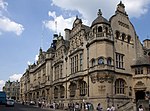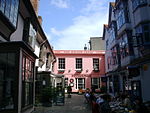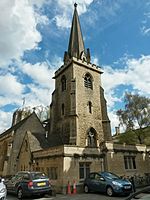Museum of Oxford

The Museum of Oxford (MOX) is a history museum in Oxford, England, covering the history of Oxford and its people. The museum includes both permanent and temporary displays featuring artefacts relating to Oxford's history from prehistoric times to the present day. The museum also acts as a public meeting space which people and organisations rent for both public and private events. Other activities facilitated by the museum include frequent public talks by historians and local cultural organisations, organised school tours, family activities, adult learning workshops, and an older people's program.The museum contains a gift shop stocked with items related to Oxford's history and cultural heritage, including books, toys, food, clothing, postcards. The museum is situated in Oxford city centre, located inside Oxford Town Hall on St Aldate's Street.
Excerpt from the Wikipedia article Museum of Oxford (License: CC BY-SA 3.0, Authors, Images).Museum of Oxford
St Aldate's, Oxford City Centre
Geographical coordinates (GPS) Address Nearby Places Show on map
Geographical coordinates (GPS)
| Latitude | Longitude |
|---|---|
| N 51.751666666667 ° | E -1.2572222222222 ° |
Address
Oxford Town Hall
St Aldate's
OX1 1BX Oxford, City Centre
England, United Kingdom
Open on Google Maps










